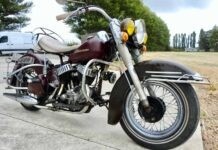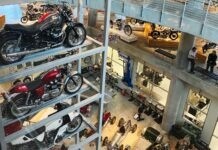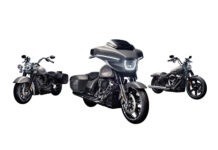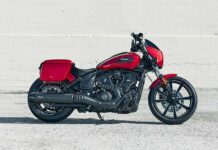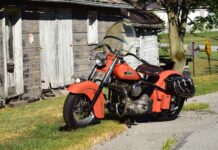Drifting to the dark side
I’m a fan of Indian: as a brand, as a company and as the underdog. There, I wrote it. Now you know there will be bias in this story—but only from a historical perspective. My first American Big Twin was a 2001 Gilroy Indian Chief, which I sold, and then I got my 1947 Indian Chief with a left-hand throttle and right-hand tank-shift foot clutch, with a stock six-volt electrical system. To me, it was the epitome of cool. I bought it off eBay, sight unseen, and the gentlemen who bought my Gilroy Indian picked it up on the way out. I remember the feeling of excitement and dread when I first tried to kick it over, and how I spent a few hours riding around our side yard, trying to figure out how to shift. Indian Motorcycle became ingrained in me, but after the fall of the Gilroy Indian brand, and me selling my ’47 for some much-needed cash, I had tucked away Indian as a distant memory.

But once Polaris got ahold of the brand, it renewed my interest, especially since they were lowering prices to something in line with what Harley was offering. I rode some of the first few Indians, and they felt unfinished, like a slightly different version of the Victory.
Today, Indian has its own identity and brand, and, with the advent of the 111-inch Thunder Stroke with a claimed 119 ft/lbs of torque, they have made their presence known. Back in 2016, the Springfield was an attempt to have a model between the Scout and Chief that could be used for longer trips but also was a bit more nimble than the Chief. It was almost a smaller version of the Chief, with the fully-skirted fenders, front and rear only, slightly lighter and a shorter wheelbase. But fully-skirted fenders aren’t for everyone. Yes, there are riders who love the nod to the vintage Indian motorcycles of yesteryear, but they are few and far between if they aren’t on an actual vintage motorcycle. I fall in the category of not loving fully-skirted fenders.

I do have an appreciation for a well-done “murdered-out” look on any vehicle, and the Springfield Dark Horse does this very well. With a standard fender on the front and a 19-inch 10-spoke contrast-cut wheel, I fell in love with this bike on a very superficial level. It had all the styling cues that I’d want an Indian to have, and a tasteful amount of flat black paint combined with gloss-black treatment on the handlebars and highway bars— enough to make me want to throw my leg over it and take it for a significant ride. Once I did get to ride it, I was floored by the nimble feel of the front end and overall ride characteristics, especially for a bike that tips the scales at just under 800 pounds. The removable windshield was adequate at deflecting the majority of the airflow, but, at just under six feet tall, I found my head bobbing while on the Interstate. (There are numerous aftermarket windshields that offer more or less wind buffeting.) The bike truly was a nimble offering around town, and it still had room for storage and a passenger.

On the Interstate, I started to drift off, wondering how this bike would feel after 500 miles. Would I be able to ride this across the country and still be mobile? I started to twist the throttle, quickly passed the other vehicles around me and became enamored with the possibilities for this bike. A quick-release trunk can be added for additional storage, as well as providing a comfortable backrest. This could bike can easily be transformed into a cross-country machine, and then stripped down again for around-town use. As it sits, the saddlebags provide enough storage for a small backpack or jacket, but they are not suited for more than an overnight, unless you are a very judicious packer. The standard cruise control is very easy to operate—further evidence of the possibility of this being a utilitarian touring bike when appointed with the proper accessories.
The stop-and-go traffic allowed me to experience a few features that are worth mentioning. The ABS-equipped dual Brembo 300mm floating rotor with 4-piston calipers up front, coupled with the single Brembo 300mm floating rotor with 2-piston calipers in back, offer plenty of even stopping power and allows for a good road feel, no matter how hard they are applied.
As I stopped at the numerous lights, with temperatures in the mid 70s, I could feel the heat on my left leg, which was odd, because the exhaust runs down the right side of the bike. I rode some more, and it cooled off. Then, as I stopped again, I felt it heat up. I don’t think there is a cure for this (I’m not a huge fan of the rear cylinder shut-off), but it is something to be aware of, and, depending on your inseam and where you sit on the bike, this may or may not be an issue for a rider.
The 19-inch wheel in front is wrapped in a Dunlop tire and offers different handling characteristics compared to the 16-inch, which comes on the standard Springfield. The width is the same, but, to keep the ride geometry correct, the sidewall of the tire has to become shorter. This means you can feel bumps more, because, as a rider, you don’t get the additional “suspension” offered by a few more inches of sidewall. Is this a game changer? No, the tradeoff is worth it in terms of styling, but ultimately you would need to ride it to see if it suits you. The matte-black front fork is a cartridge type, so there is no way to adjust it. The rear air suspension, however, is adjustable, which is great, and it can be dialed in for maximum performance, depending on how weighted down the bike is.
I began to notice more styling details that had evaded me on initial inspection that made me appreciate the time and effort the Indian Motorcycle took. The thoughtful amount of chrome on the engine was just enough to set off the black. The standard remote-locking hard saddlebags gives the rider the peace of mind to leave personal items on the bike. The matte-black dash is easy to read and simple to set up. The black solo leather seat allows the rider to imagine a solo trip where they throw their leg over the Indian Springfield Dark Horse and head for their favorite local establishment, or take it out on the highway, set the cruise control and point it to parts unknown. Either way, it is perfectly suited and will turn heads. And it brings back great memories of Indians I have had before.



